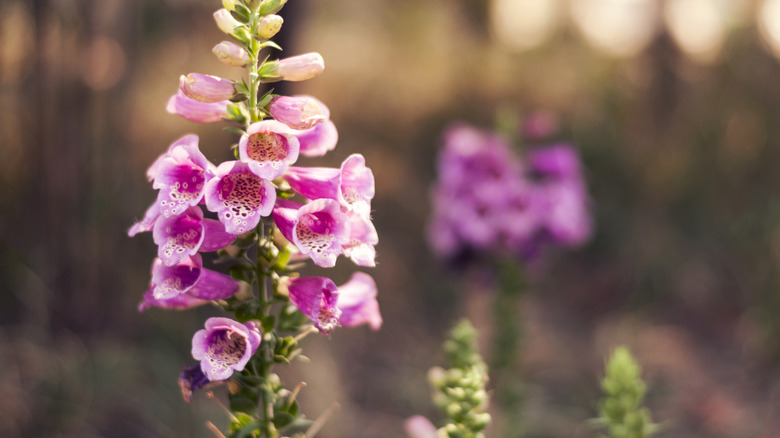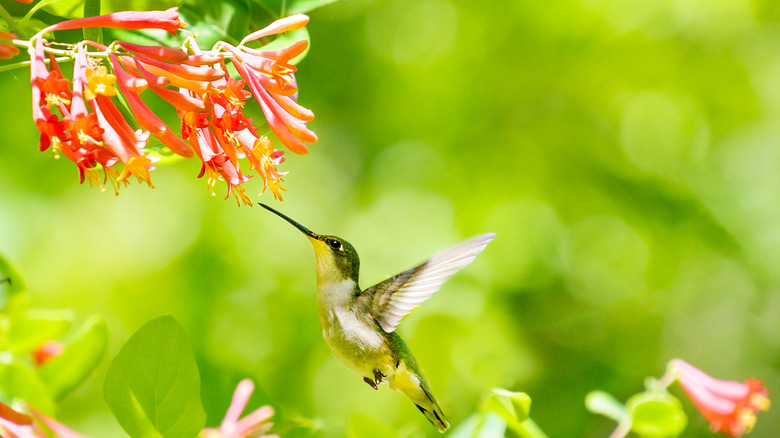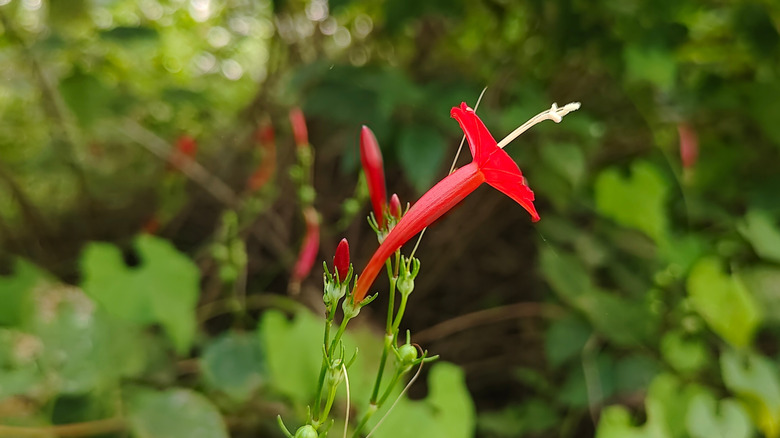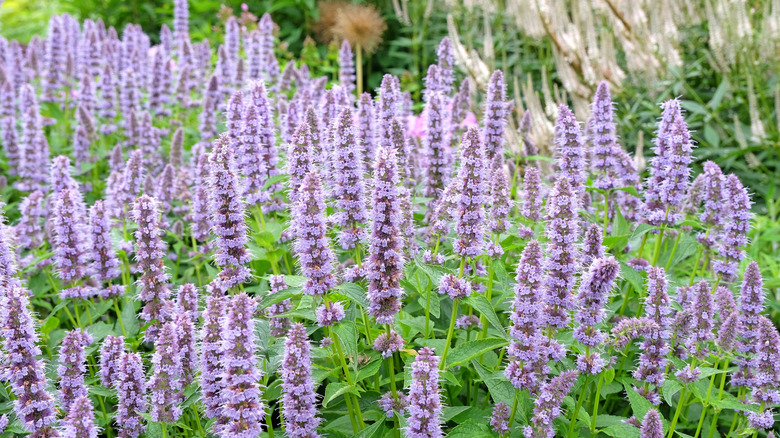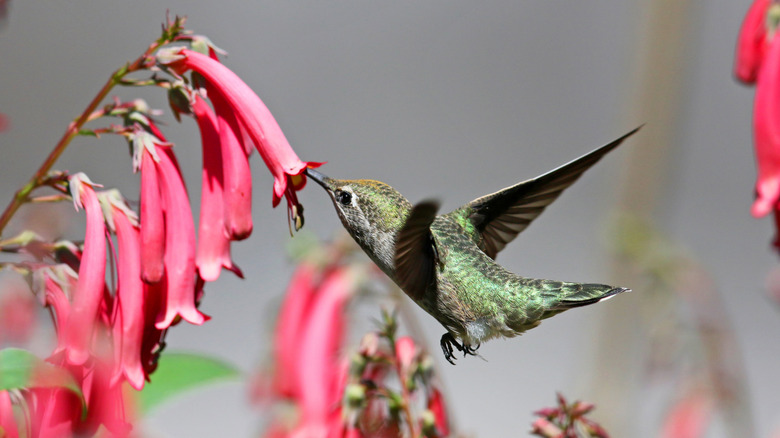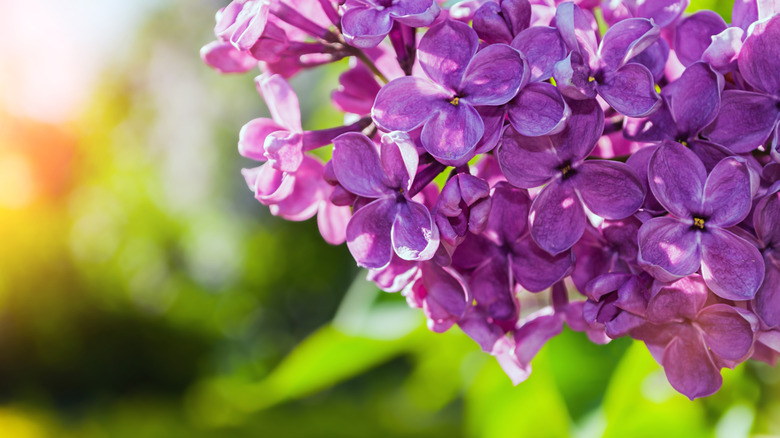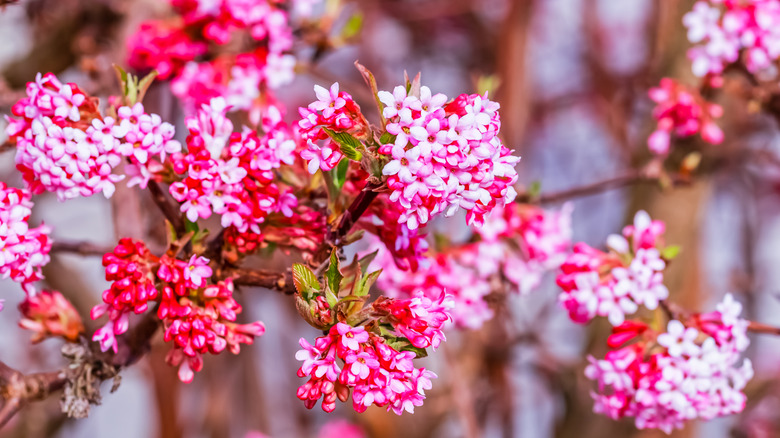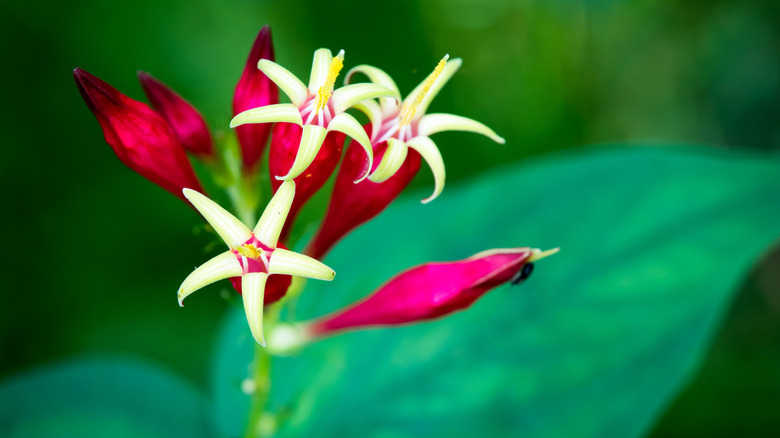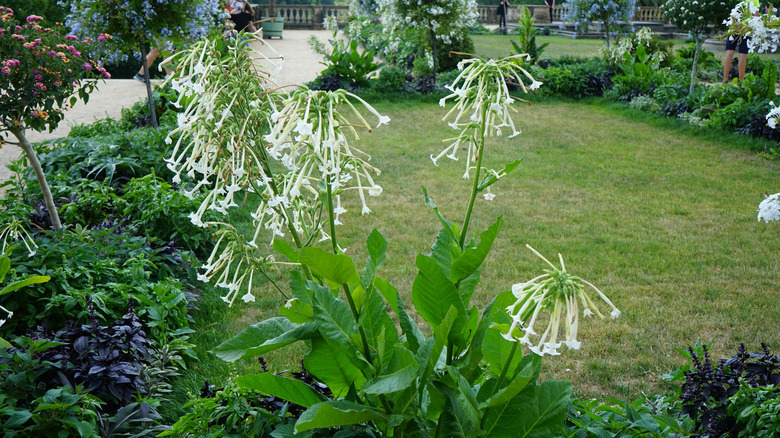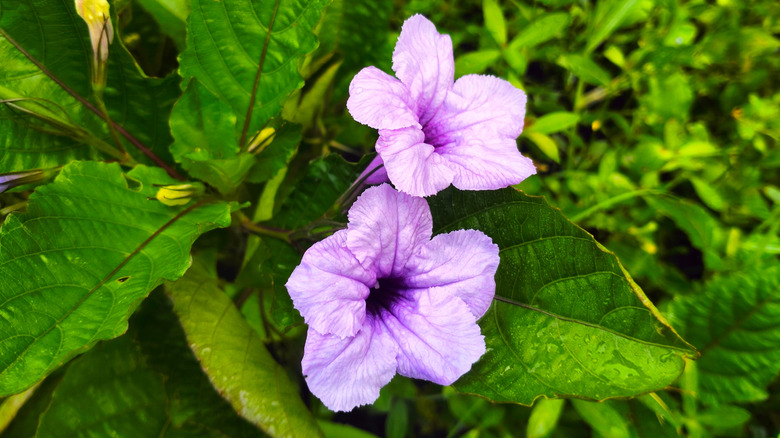The 13 Best Types Of Tubular Flowers To Lure Hummingbirds To Your Yard
"Sunshine, flowers, and hummingbirds: the perfect recipe for a day of pure delight." An unnamed human stated this nugget of truth. The sunshine part is beyond our control, but you can try your best to bring in the birds by planting the right kinds of flowers. Tubular flowers are the perfect fit for hummingbirds' long beaks and tongues, and it's not a coincidence. Flowers with elongated blooms evolved in harmony with the hummingbirds that live in their biomes. Stock your yard with spectacular tubular flowers that hummingbirds can't resist; it's a smart step toward mixing up your own batch of pure delight.
The planet supports countless flower species that are delicious to hummingbirds. Of course, there are plants that only grow in certain areas. Scanning the hummingbirds' floral buffet choices, there are a handful of tubular blossoms that can thrive in a wide range of growing zones. From beardtongues to wild petunias, we've assembled the top menu choices to tuck into your flower beds this year and host many a hummingbird feast.
Beardtongue
Penstemons (Penstemon spp.) also go by the handle "beardtongue". It might not be the most romantic name for these gorgeous plants, but their elongated blooms are made for hummingbirds. As a genus, penstemons flourish in most hardiness zones, from 3 to 10, but the geographical distribution of the species varies. For example, white-flowered foxglove beardtongue is native in the eastern half of the U.S. It thrives in zones 4 to 8, from the chilly north to the scorching south. Meanwhile, inhabitants of the Rockies can enjoy Rocky Mountain beardtongue, and pine-needle beardtongue performs beautifully in hot, rocky desert regions.
Trumpet honeysuckle
The tiny red pipes hanging from trumpet honeysuckle (Lonicera sempervirens) look like the ideal flowers for hummingbirds. True to honeysuckles' nature, this species is vigorously vining, but, luckily, not invasive — unlike Japanese honeysuckle (Lonicera japonica). Trumpet honeysuckles perform best in full sun in zones 4 to 9. This prodigious grower can reach heights of 20 feet and widths of up to 6 feet, so plan accordingly when planting. However, this plant is highly flammable, so don't plant it within your home's defensible zone.
Cardinal climber
With the common name of "cardinal climber" (Ipomoea sloteri), it's no surprise that this vining plant sports tubular flowers in a red color reminiscent of a male cardinal. Unlike many of its morning glory cousins, this species isn't listed among invasive plants. Cardinal climbers love full sun and moist, well-draining soil and are hardy in zones 10 to 12. It's one of the most stunning plants to grow along a fence, where its blooms will attract hummingbirds from June through September.
'Honeybells' cuphea
'Honeybells' cuphea (Cuphea x 'Honeybells') could go by the name of "dinner bell" for hummingbirds. But the birds aren't the only creatures who will love having this Cuphea hybrid in the yard; the deep pink tubes edged with yellow are a joy for humans, as well. Cupheas in general are low maintenance and flower best when planted in full sun. These heat-loving blossoms are perennial in zones 8 and up, but you can grow them as annuals in colder areas.
Firecracker cuphea
A cousin of the 'Honeybells,' the firecracker cuphea (Cuphea ignea), is the feistier member of the family, and its tubular blooms are equally appealing to hummingbirds. Also called the Mexican cigar plant, firecracker flowers look like caffeinated versions of the more demure 'Honeybells'. Firecracker cupheas are hardy in zones 10 to 12 and are easy to grow. They're not particular about soil quality but will do best in partial to full sunlight.
Hummingbird mint
The name says it all: Hummingbird mint (Agastache) is meant for our high-energy friends. It also goes by the name giant hyssop, and you can find it flourishing in zones 5 to 10. At first glance, you may not realize that the flowers are tiny tubes. The light purple blossoms are very enticing to hummingbirds and other pollinators. Plant hummingbird mint in full sun. It will prosper in rocky or sandy soils.
Cape fuchsia
Another flower whose advertising team was right on target for hummingbirds, cape fuchsia (Phygelius capensis), boasts clusters of bright red tubes promising birds a satisfying meal. Cape fuchsia may also be referred to as the less-flattering "cape figwort," but the harsh name doesn't deflect from this plant's showy beauty. It's hardy in zones 7 through 10 and is evergreen in zones 8 and up. Cape fuchsia grows best in full sun but is otherwise easygoing. It isn't picky about soil and needs an average amount of water and maintenance.
Lilac
Common lilacs (Syringa vulgaris) are indeed common, but catching sight or a whiff of them can still provide a thrill. This springtime northern garden staple is like a living hummingbird restaurant. Lilac bushes wear generous bundles of pale purple tubular flowers that beckon to the birds. Lilacs are hardy in zones 3 to 8. While they are cold tolerant, your lilac will bloom best if planted in a warm spot with lots of sun. It will make do in most types of soil as long as they're well draining.
Virburnum
As long as you stick with its native species, viburnum is a great choice for luring in hummingbirds. There are scores of viburnum species that flaunt flashy sprays of blossoms in spring. However, do note that there's an eyebrow-raising list of invasive viburnums. Stick with safe ones like arrowwood, blackhaw, or nannyberry. Both nannyberry and arrowwood are suited for zones 2 to 8, while blackhaw thrives in zones 3 to 9. There are also native varieties that are good fits for warmer zones, like Walter's viburnum. Plant these beauties in shade or full sun in well-draining clay, loam, and sandy soils.
Indian pink
Indian pink flowers (Spigelia marilandia) are made up of upright orangey-red cones that wag yellow banners at pollinators. Hummingbirds can't stay away from this tubular flower. They're a bit more choosy about living conditions than other flowers on our list. However, if you live in zones 6 to 9 and can lend them a shady to half-shady corner with moist-to-wet soil, you can grow this plant and render your hummingbird guests ecstatic.
Virginia bluebells
While its name may have you picturing a flower that only grows south of the Mason-Dixon line, Virginia bluebells (Mertensia virginica) are tough enough to live in places like Quebec and Minnesota, and its native terrain ranges from Canada to as far south as Alabama. Hummers love to sip from these bluish lavender blooms, but there's an extra incentive to plant Virginia bluebells — these sublime flowers are threatened in their native range, so consider giving them a helping hand by planting them. Inhabitants of zones 3 to 9, why not start some Virginia bluebell seeds in a moist, shaded spot?
Flowering tobacco
Those living outside of tobacco's native range may be surprised to learn that its flowers are truly lovely. Flowering tobacco (Nicotiana sylvestris), which belongs to the same genus as smoking tobacco, produces creamy white, fragrant blooms that hummingbirds can't resist. The plant's other common name, "white shooting stars," is descriptive enough to make a photo unnecessary. Plant flowering tobacco in full sun to partial shade in well-draining soils. The species succeeds in zones 10 and 11.
Wild petunia
Picturing a petunia, your mind's eye sees a floret that resembles an old-timey phonograph. Dip past its petals, and a nectar-filled tube awaits your hungry hummingbird visitors. Wild petunias (Ruellia humilis) are an offbeat relation to the petunias we see every summer. Instead of the dazzling jewel-tones we're used to, these petunias dance on their stems in pale lavender skirts. Wild petunias have medium maintenance and water requirements. If you live in zones 4 to 8, stake out a section of your garden with full sun to part shade and well-draining soil to sow some of these seeds.

